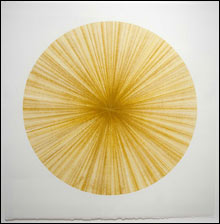
SCULPTING WITH CHALK “Untitled (yellow radial),” by August Ventimiglia, 2010. |
August Ventimiglia isolates simple gestures and records their impact and reverberations, magnifying the grace of the adjusting and settling physical world, and implying larger social and philosophical commentary. Using saturated earthy materials that are both industrial and fragile, the snapping of a line, the grinding of chalk, the wearing of sandpaper, and the settling of dust are captured and made permanent. In a show of drawings of various scales at MECA's June Fitzpatrick Gallery, 30 recent works show Ventimiglia's deliberation over severe control and chaos, illuminating the gusts and whispers that reside somewhere between. Breeding minimalist formal themes with the documentation of action, the artist meditates on process and materiality. Simple geometric forms are used to investigate and express the results of formal and material experiments with shifting variables.In "Untitled (yellow radial)," a circle is sculpted from ochre chalk dust applied to a construction snap-line and cracked against paper at scrupulously equal radial distances. The varying rigor with which the line is snapped imprints corresponding amounts of residue onto the pristine paper, building an architecture of vibrating straight lines cutting through billowy or explosive settled excess chalk. The messiness of the industrial action is contained by a stark negative space, defining the form, rendering it weightless, and pushing against it. A collection of dust sits precariously in the concentrated center of the round, quietly provoking disruption and threatening to just drift away.
This tension is prevalent throughout Ventimiglia's work: between tightly drawn lines, the strain of a snap-line scar and airy torrents of dust, in an exhaustive intervention of materials, and to an extent, in the acknowledgement of the hand and suggestion of imperfection. The artist uses tape to build his forms, resulting in sharp, clean delineations of space. When abutting the unadulterated white, areas of negative space where dust is allowed to settle appear dirty and evince their dusty creation. A 36-by-138-inch site-specific wall drawing, "Untitled (rise in black)," best exposes the artist's process. An ascending scalene triangle built using the snap-line procedure, a form and method explored at length in the exhibit, is inflated and allowed to expand and breathe in the gallery. The irregularities and patterns that emerge from the repetition of the snapping action and disparate reactions to the paper develop a vibrant texture and rhythmic quality only suggested in the smaller works, and emphasize the performative element of Ventimiglia's practice. The installation of this wall piece involved several days of taping off, measuring out, and wielding the snap-line, and required a large plastic tent to contain all the residual black chalk powder.
Ventimiglia, coming from a family of sculptors and architects, clearly has a meticulous eye, trained hand, and command for formal composition. What makes his work most compelling, however, is his concurrent embrace of the unplanned and the incidental. Where his rich "Stitches" in Yves Klein blue would stand on their own as carefully considered formal line drawings, the delicately contained constellations of chalk dust that could only be composed by the random forces of nature pushing and pulling them as they descend to the paper are what the eye spends time with. By documenting the unintentional, Ventimiglia pays respect to the repercussions of his actions, which, here, are beautiful.
Annie Larmon can be reached at aglarmon@gmail.com.
"AUGUST VENTIMIGLIA: NEW DRAWINGS" | through April 30 | at the June Fitzpatrick Gallery at MECA, 522 Congress St, Portland | 207.699.5083